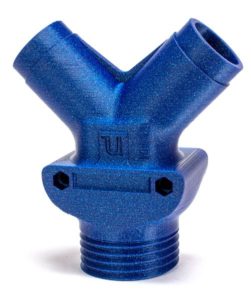

3D PRINTLIFE SAMPLE FILAMENT DRIVERS
Because of its early acceptance, industries including automotive, aerospace, and healthcare have been significant drivers for 3D printing in India. The Indian government's Make in India project is assisting the country's aim of becoming a worldwide manufacturing powerhouse. India is one of the fastest-growing markets for 3D printing, and the country's manufacturing industry is quickly expanding, with the country's manufacturing sector anticipated to become the world's fifth-biggest by 2021. Approximately USD 150.0 million was invested in the Singapore Center of 3D Printing (SC3DP) for research efforts in 3D printing technology during the last decade. For example, the UK government announced a USD 150 million investment in the Advanced Manufacturing Research Centre in Rotherham and Sheffield, as well as the Nuclear Advanced Manufacturing Research Centre in Rotherham, in 2018. With the projected advancements in 3D printing and scanning technologies, significant investment initiatives in the digital economy by European and Asian governments are likely to produce strong momentum in these areas in the near future. If the Kickstarter is a success, backers can expect to see their rewards shipped out as of August 2017.Various governments across the world are launching programs to encourage the use of 3D printing technology in various sectors. Backers can choose from a broad range of rewards, including a small 100 g spool of BioPETG for $10, a 500 g spool for $30, a 750 g spool for $37, and many more. The spool is designed to fit most 3D printers, and features a cutout for viewing the filament and puncture slots for securing it.Īs mentioned, 3D Printlife has just launched a crowdfunding campaign for its BioPETG filament, the funds from which will help to produce a range of 12 to 18 different colors in both 1.75mm and 2.85mm diameters. This means that its filaments are wound around 100% recycled and biodegradable cardboard spools, and secured with a recyclable tin cap. In addition to offering eco-friendly filaments, 3D Printlife also ensures that its filaments are packaged in an environmentally conscious way. 2mm gap in the Z axis to reduce risk of skimming Nozzle temperature: between 235☌ and 250☌.

The L.A.-based company has provided some print settings that should optimize the filament, which include: Additionally, the company says its material is largely odorless when melted, as PETG has a high temperature and chemical resistance.


If you’re wondering whether this means the filament will begin to degrade on the spool or once it’s been printed, 3D Printlife assures that the biodegradation should only occur when the plastic is in a compost or landfill facility, where the harsh bacteria needed to consume the BioPETG exists.įrom a 3D printing perspective, the BioPETG filament, which 3D Printlife has tested extensively, offers users high impact resistance, durability, strength, good layer adhesion, and low shrinkage. As the company explains, “This additive is specially formulated to bond with PETG and provide a food source for the bacteria found in both commercial composts and landfill to energy facilities.” Thanks to 3D Printlife’s innovative filament making process, which involves adding a proprietary, biological additive to the PETG, they have found a way to make it biodegradable. One of the most common plastics, as well as one of the easiest to recycle, PETG has, up until now, remained un-biodegradable. PETG, also known as copolyester, is a material made of PET and glycol, a compound that adds flexibility and durability to the material, qualities that are important when 3D printing. The company, which currently offers US-made Enviro ABS, PLAyPHAb PLA/PHA, and Pure PLA, is hoping to expand its product selection with the addition of BioPETG, the first biodegradable PETG. Launched earlier today, 3D Printlife’s Kickstarter campaign is seeking to raise $20,000 for the high quality, environmentally friendly PETG filament.ģD Printlife has dedicated itself to the creation of eco-friendly 3D printing filaments. The company, which already offers eco-friendly ABS and PLA filaments, is hoping to bring its innovative bio-degradable BioPETG filament to market in 12 to 18 different colors. Los Angeles-based 3D printing filament manufacturer 3D Printlife has launched a Kickstarter campaign for its new eco-friendly PETG filament.


 0 kommentar(er)
0 kommentar(er)
